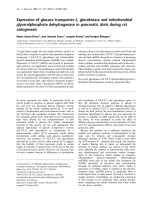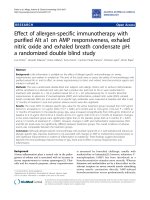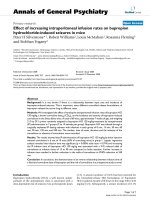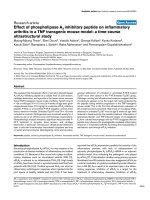Báo cáo y học: "Effect of litter separation on 24-hour rhythmicity of plasma prolactin, follicle-stimulating hormone and luteinizing hormone levels in lactating rabbit does" pdf
Bạn đang xem bản rút gọn của tài liệu. Xem và tải ngay bản đầy đủ của tài liệu tại đây (345.19 KB, 5 trang )
BioMed Central
Page 1 of 5
(page number not for citation purposes)
Journal of Circadian Rhythms
Open Access
Research
Effect of litter separation on 24-hour rhythmicity of plasma
prolactin, follicle-stimulating hormone and luteinizing hormone
levels in lactating rabbit does
Pilar Cano
1
, Vanessa Jiménez
1
, Maria P Álvarez
2
, Mario Alvariño
3
,
Daniel P Cardinali
4
and Ana I Esquifino*
1
Address:
1
Departamento de Bioquímica y Biología Molecular III, Facultad de Medicina, Universidad Complutense de Madrid, 28040 Madrid,
Spain,
2
Departamento de Biología Celular, Facultad de Medicina, Universidad Complutense de Madrid, 28040 Madrid, Spain,
3
Departamento de
Producción Animal, E.T.S.I. Agrónomos, Universidad Politécnica de Madrid, Spain and
4
Departamento de Fisiología, Facultad de Medicina,
Universidad de Buenos Aires, 1121 Buenos Aires, Argentina
Email: Pilar Cano - ; Vanessa Jiménez - ; Maria P Álvarez - ;
Mario Alvariño - ; Daniel P Cardinali - ; Ana I Esquifino* -
* Corresponding author
Abstract
Background: This work describes the effect of a 48-h litter separation on 24-h patterns of plasma
prolactin, FSH and LH concentration in female lactating rabbits kept under a 16:8 light-dark
photoperiod (lights on at 0800 h).
Methods: Groups of 6–7 female lactating rabbits maintained with their litters or separated from
them for 48 h were killed by decapitation on day 11 post-partum, at 6 different time points
throughout a 24-h cycle, starting at 0900 h. Plasma levels of prolactin, FSH and LH were measured
by specific double antibody radio-immunoassays.
Results: Plasma level of prolactin in control and separated does changed in a similar way
throughout the day, showing two maxima, at 0500–0900 h and at 1700–2100 h, respectively. Litter
separation significantly augmented plasma FSH and LH and disrupted their 24-h rhythmicity.
Conclusion: Since previous studies had shown that litter separation for short periods of time
augmented sexual receptivity and fertility of the doe, the changes in FSH and LH reported may
influence the massive release of gonadotropin releasing hormone, LH and FSH triggered by mating
or artificial insemination in litter-separated mothers.
Introduction
In nursing rabbits, sexual receptivity and fertility achieved
after artificial insemination is depressed during the period
of lactation, presumably through a hormonal antagonism
between prolactin and gonadotropin release [1-3]. Several
studies have demonstrated that separation of the doe
from its litter for short periods of time, prior to artificial
insemination, is very effective in stimulating ovarian
activity in the mother [4-6], with endocrine changes that
may explain the activation of ovarian function [7-9] Thus,
separation of the does from their litters could be an effec-
tive procedure to augment breeding efficiency under farm
conditions [5-7].
Published: 02 June 2005
Journal of Circadian Rhythms 2005, 3:9 doi:10.1186/1740-3391-3-9
Received: 05 April 2005
Accepted: 02 June 2005
This article is available from: />© 2005 Cano et al; licensee BioMed Central Ltd.
This is an Open Access article distributed under the terms of the Creative Commons Attribution License ( />),
which permits unrestricted use, distribution, and reproduction in any medium, provided the original work is properly cited.
Journal of Circadian Rhythms 2005, 3:9 />Page 2 of 5
(page number not for citation purposes)
It must be noted that the published studies on the endo-
crine changes taking place in the doe after litter separation
have been performed at single time points in the daily
cycle, usually in the morning, which is an important draw-
back in view of the circadian nature of the secretion of the
pituitary hormones involved [10,11]. Indeed a number of
circadian functions have been examined in rabbits [12-
17], but there is no information on 24-h pattern of hor-
mone release. This prompted us to undertake the present
study whose aim was to examine the effect of litter separa-
tion for 48 h on 24-h changes in plasma prolactin (PRL),
follicle stimulating hormone (FSH) and luteinizing hor-
mone (LH) levels of the doe. Specifically, we sought to
answer two questions: (i) did suppression of a major neu-
roendocrine and circadian stimulus like the stimulation
of nipples by the lactating pup affect the 24-h changes in
gonadotropin and prolactin release?; (ii) could the
changes in circulating hormone levels be related to aug-
mentation of breeding efficiency found after litter separa-
tion from the doe?
Materials and methods
Animals
The study was performed in 84 multiparous, lactating Cal-
ifornian x New Zealand White crossbreed female doe rab-
bits. Animals were housed in the research facilities of the
Animal Production Department, Universidad Politécnica
de Madrid, under controlled light-dark cycles (LD 16:8,
light on at 8:00 h), housed in individual metal cages, fed
at libitum using a commercial pellet diet (Lab Rabbit
Chow, Purina Mills, Torrejón de Ardoz, Madrid, Spain)
and having access to tap water ad libitum. The study was
performed according to the CEE Council Directives (86/
609, 1986) for the care of experimental animals. Groups
of 6–7 female lactating rabbits were maintained with their
litters or separated from them for 48 h, starting at different
times (i.e., at 09:00, 13:00, 17:00, 21:00, 01:00 or 05:00
h). Ninety five percent of the does suckled the pups
between 03:30 and 04:30 h during the dark period, as has
been previously described [16]. On day 11 post-partum,
the does were killed by decapitation at 6 different time
points throughout a 24-hour cycle starting at 0900 h.
Blood was collected from the cervical wound and the
plasma was separated to measure prolactin and gonado-
tropin concentration.
Hormone assays
Plasma prolactin, FSH and LH levels were measured in
duplicate samples by specific RIA methods [18] using
AFP-991086, AFP-472176 and AFP-3120489 antibodies
for prolactin, FSH and LH respectively, supplied by the
National Institute of Health (NIH, Bethesda, MD, USA)
and Dr. A. F. Parlow (Harbour-UCLA Medical Center, CA,
USA). Hormones were labeled with
125
I by the Chlo-
ramine T-method [19]. The antibody titers used were
1:62,500 for prolactin, 1:45,000 for FSH and 1:250,000
for LH assays, respectively. The volume of plasma used
was 10 µl (prolactin assay), 75 µl (FSH assay) and 100 µl
(LH assay). Staphylococcus aureus (prepared by the Depart-
ment of Plant Physiology, U.A.M., Madrid, Spain) was
used to precipitate the bound fraction [18]. The assays
were previously validated in our laboratory [18]. All sam-
ples were measured in the same assay run to avoid inter-
assay variations. The limits of detection for prolactin, FSH
and LH were 0.125, 0.48 and 0.05 ng/mL respectively. The
intra-assay coefficient of variation, calculated from a pool
of plasma measured ten times in the same assay, was <
5%.
Statistical analysis
After determining that the homogeneity-of-variance
assumption was tenable and that the distribution
appeared unimodal and nonskewed, the statistical analy-
sis of results was performed by a two-way factorial analy-
sis of variance (ANOVA). Generally, the factorial ANOVA
included assessment of the group effect (i.e. the occur-
rence of differences in mean values between control and
separated groups), of time of day effects (the occurrence of
daily changes) and of the interaction between the two fac-
tors (separation and time, from which inference about dif-
ferences in timing and amplitude could be obtained). A
one-way ANOVA followed by Student-Newman-Keuls'
test was then employed to show which time points were
significantly different within each experimental group to
define the existence of peaks. A Student's t test was per-
formed to assess differences between the experimental
groups at particular time intervals. P values lower than
0.05 were considered evidence for statistical significance.
Results
Figure 1 depicts the plasma prolactin levels through a 24-
h cycle in control does and in does separated from their
litters for 48 h. Analyzed as a main factor in a factorial
ANOVA, significant time of day changes occurred (F =
35.4, p < 0.00001) with absence of any significant effect
of litter separation. Both in control and separated does,
plasma level of prolactin changed throughout the day
showing two maxima, at 0500 – 0900 h and at 1700 –
2100 h, respectively (p < 0.001, Figure 1).
Figure 2 shows the 24-h changes in plasma FSH concen-
tration in control does and in does separated from their
litters for 48 h. Analyzed as a main factor in a factorial
ANOVA, litter separation augmented FSH levels by 37 %
(F = 104.6, p < 0.00001). A significant effect of time of day
and a significant interaction "time of day x litter separa-
tion" were found (F = 41.1 and 23.3, p < 0.00001, respec-
tively), i.e., a single maximum in the first half of the light
period was seen in controls whereas two maxima, at 0500
Journal of Circadian Rhythms 2005, 3:9 />Page 3 of 5
(page number not for citation purposes)
– 0900 h and at 1700 – 2100 h, respectively, were found
after litter separation.
Figure 3 displays the 24-h changes in plasma LH concen-
trations. A significant effect of litter separation and time of
day was apparent (F = 16.1, p < 0.0001 and F = 2.51, p <
0.03, factorial ANOVA). Litter separation brought about a
small albeit significant 16% increase in mean circulating
LH values. As shown by the significant interaction "time
of day x litter separation" found (F = 29.4, p< 0.00001),
litter separation disrupted the plasma LH rhythm by
phase-shifting its maximum by 12 h, from 1300 h in con-
trols to 0100 h in separated mothers (Figure 3).
Discussion
The questions posed in the Introduction may now be
answered. First, our results indicate that the 24 h patterns
of plasma FSH and LH, but not of prolactin, changed sig-
nificantly in nursing rabbits after litter separation for 48 h.
Second, litter separation disrupted the 24-h rhythmicity of
plasma FSH and LH concentration and caused a moderate
increase in their concentration (when assessed as the
mean 24-h values). Previous studies in the rabbit showed
that litter separation for short periods of time augmented
sexual receptivity and fertility of the doe [4-9]. Thus, the
changes in gonadotropins reported herein could be a
reflection of the same mechanisms involved in the
massive release of gonadotropin releasing hormone
(GnRH), LH and FSH triggered by mating or artificial
insemination in litter-separated mothers.
The rabbit exhibits an unusual form of maternal care, with
a single and very short visit (3–5 min) every day to nurse
[20]. This daily nursing visit of the doe is extremely regu-
lar, with some individuals showing a day-to-day variabil-
ity of only a few minutes. Estrogen, androgen,
progesterone and prolactin promote the onset of this
behavior in does [21] while its maintenance relies on
stimuli from the litter (i.e., maternal responsiveness is
altered or abolished by prevention of mother/young con-
tact at parturition or during early lactation). From a
number of studies on the distribution of estrogen, andro-
gen and prolactin receptors, quantification of expression
of immediate-early genes, and lesions of structures of the
olfactory system, it was concluded that rabbits rely on the
24-h changes in plasma prolactin levels in female lactating rabbitsFigure 1
24-h changes in plasma prolactin levels in female lac-
tating rabbits. Groups of 6–7 animals maintained with their
litters or separated from them for 48 h were killed by decap-
itation on day 11 post-partum, at 6 different time points
throughout a 24-h cycle, starting at 0900 h. The dark bar
indicates scotophase duration. Results are the means ± SEM.
Letters indicate the existence of significant differences
between time points in each group after a one-way ANOVA
followed by a Student-Newman-Keuls' test, as follows:
a
p <
0.05 vs. 09:00 and 17:00 h,
b
p < 0.01 vs. 09:00 h, p < 0.05 vs
05:00 h. For further statistical analysis, see text.
24-h changes in plasma FSH levels in female lactating rabbitsFigure 2
24-h changes in plasma FSH levels in female lactating
rabbits. Groups of 6–7 animals maintained with their litters
or separated from thrm for 48 h were killed by decapitation
on day 11 post-partum, at 6 different time points throughout
a 24-h cycle, starting at 0900 h. The dark bar indicates sco-
tophase duration. Results are the means ± SEM. Asterisks
indicate significance differences with control at that particular
time interval (Student's t test, * p < 0.05, ** p < 0.01). Letters
indicate the existence of significant differences between time
points in each group after a one-way ANOVA followed by a
Student-Newman-Keuls' test, as follows:
a
p < 0.01 vs. all
remaining groups,
b
p < 0.05 vs. 17:00 h,
c
p < 0.01, vs 09:00,
13:00, 21:00 and 05:00 h, p < 0.05 vs. 17:00 h. For further
statistical analysis, see text.
Journal of Circadian Rhythms 2005, 3:9 />Page 4 of 5
(page number not for citation purposes)
same hormonal and extrahormonal factors that stimulate
maternal behavior in other mammals except for the very
peculiar circadian nursing pattern that is unique to rabbits
[22-24].
Since the early observations by McNeilly and Friesen [25]
it is known that postpartum blood levels of prolactin are
similar in lactating and postpartum nonlactating females.
Such an observation was confirmed in the present study in
which plasma prolactin levels, measured at six time inter-
vals in a 24-h cycle (the closest to nursing time was at
05:00 h), were essentially similar in control and litter-sep-
arated does. In lactating females, suckling evoked an
immediate increase (3- to 5-fold) in circulating prolactin
levels, an effect mimicked by the tactile stimulation of the
teats [25]. Likewise, in hares, prolactin levels increased
significantly during lactation only after suckling stimuli
[26]. It must be noted that, in contrast to rabbits, plasma
prolactin levels are significantly changed by nursing in
most species, the suckling stimulus being an effective
masking signal for the 24-h release of prolactin [27,28].
This does not occur in the doe, the circadian changes of
plasma prolactin levels remaining essentially unchanged
after litter separation (presumably because of the very
short nursing period). This suggests that the circadian
secretion of prolactin and the prolactin response to phys-
ical stimulation of the nipples are independent phenom-
ena that occur throughout the nursing period.
Previous reports using single sampling procedures [8]
indicated that litter separation decreased thr doe's prolac-
tin levels and did not affect FSH. Discrepancies are possi-
bly dependent on the sampling frequency and time of day
examined. Collectively, the results underline the
importance of performing 24-h studies to have a more
precise picture of the hormonal changes.
Litter separation disrupted the 24-h rhythmicity of both
FSH and LH significantly. McNeilly [29] suggested that a
reduction of plasma LH levels found during the light
period could be coupled to an increase of pulsatile pattern
of hypothalamic GnRH release. In the present study, the
does exhibited, after litter separation, an inverse 24-h pat-
tern of LH release with the lowest values during the light
phase of daily photoperiod. Presumably, the disrupted
24-h rhythmicity of LH (and FSH) are linked to the greater
mating or artificial insemination-induced release of LH
and FSH found in does separated from their litters.
In summary, the present study demonstrates the existence
of 24-h variations in circulating prolactin, LH and FSH
levels in nursing does. Litter separation for short periods
of time, an effective procedure to stimulate ovarian activ-
ity prior to artificial insemination, markedly influences
the secretory patterns of FSH and LH, a finding that can be
related to the higher reflex ovulatory response to mating
or artificial insemination observed in does separated from
their pups. The specific value of the present study in terms
of augmenting breeding efficiency should be further
explored.
References
1. Theau-Clément M, Roustan A: A study on relationships between
receptivity and lactation in the doe and their influence on
reproductive performances. J Appl Rabbit Res 1992, 15:412-421.
2. Fortum L, Bolet G: Les effects de la lactation sur les perform-
ance de reproduction chez la laprine. INRA Prod Anim 1995,
8:44-56.
3. Ubilla E, Rebollar PG: Influence of the postpartum day on
plasma oestradiol concentrations, sexual behaviour and con-
ception rate, in artificially inseminated lactating rabbits. Anim
Reprod Sci 1995, 38:337-344.
4. Pavois V, LeNaour J, Ducep O, Perrin G, Duperray J: A natural
method to improve sexual receptivity and fertility in artifi-
cially inseminated rabbits. Gémes Journées de la Recherche Cunicole
la Rochelle 1994, 2:528-535.
5. Alvariño JMR, Del Arco JA, Bueno A: Effect of mother-litter sep-
aration on reproductive performance of lactating rabbit
female inseminated on day 4 or 11 post partum. World Rabbit
Sci 1998, 6:191-194.
24-h changes in plasma LH levels in female lactating rabbitsFigure 3
24-h changes in plasma LH levels in female lactating
rabbits. Groups of 6–7 animals maintained with their litters
or separated from them for 48 h were killed by decapitation
on day 11 post-partum, at 6 different time points throughout
a 24-h cycle, starting at 0900 h. The dark bar indicates sco-
tophase duration. Results are the means ± SEM. Asterisks
indicate significance differences with control at that particular
time interval (Student's t test, * p < 0.05, ** p < 0.01). Letters
indicate the existence of significant differences between time
points in each group after a one-way ANOVA followed by a
Student-Newman-Keuls' test, as follows:
a
p < 0.05 vs 21:00,
01:00 and 05:00 h,
b
p < 0.05, vs 05:00 h,
c
p < 0.01 vs. 09:00,
21:00, 01:00 and 05:00 h,
d
p < 0.05 vs. 21:00, 01:00 and 05:00
h. For further statistical analysis, see text.
Publish with BioMed Central and every
scientist can read your work free of charge
"BioMed Central will be the most significant development for
disseminating the results of biomedical research in our lifetime."
Sir Paul Nurse, Cancer Research UK
Your research papers will be:
available free of charge to the entire biomedical community
peer reviewed and published immediately upon acceptance
cited in PubMed and archived on PubMed Central
yours — you keep the copyright
Submit your manuscript here:
/>BioMedcentral
Journal of Circadian Rhythms 2005, 3:9 />Page 5 of 5
(page number not for citation purposes)
6. Maertens L: Effect of flushing, mother-litter separation and
PMSG on the fertility of lactating does and the performance
of the litter. World Rabbit Sci 1998, 6:185-190.
7. Castellini C, Canali C, Boiti C: Effect of mother-litter separation
for 24-hour by closing the nestbox or change of cage, on rab-
bit doe reproduction performance. World Rabbit Sci 1998,
6:199-203.
8. Ubilla E, Rebollar PG, Pazo D, Esquifino A, Alvariño JMR: Effects of
doe-litter separation on endocrinological and productivity
varibles in lactating rabbits. Livestock Prod Sci 2000, 67:67-74.
9. Ubilla E, Rebollar PG, Pazo D, Esquifino AI, Alvariño JMR: Endocrine
profiles during doe-litter separation and the subsequent
pregnancy in rabbits. J Physiol Biochem 2001, 57:23-29.
10. García-Bonacho M, Esquifino AI, Castrillón PO, Reyes Toso C, Car-
dinali DP: Age-dependent effect of Freund's adjuvant on 24-
hour rhythms in plasma prolactin, growth hormone, thyro-
tropin, insulin, follicle-stimulating hormone, luteinizing hor-
mone and testosterone in rats. Life Sci 2000, 66:1969-1977.
11. Esquifino AI, Chacon F, Jimenez V, Reyes Toso CF, Cardinali DP: 24-
hour changes in circulating prolactin, follicle-stimulating
hormone, luteinizing hormone and testosterone in male rats
subjected to social isolation. J Circadian Rhythms 2004, 2:1.
12. Jilge B, Stahle H: The internal synchronization of five circadian
functions of the rabbit. Chronobiol Int 1984, 1:195-204.
13. Jilge B, Hornicke H, Stahle H: Circadian rhythms of rabbits dur-
ing restrictive feeding. Am J Physiol 1987, 253:R46-R54.
14. Jilge B: Restricted feeding: a nonphotic zeitgeber in the rabbit.
Physiol Behav 1992, 51:157-166.
15. Jilge B, Stahle H: Restricted food access and light-dark: impact
of conflicting zeitgebers on circadian rhythms of the rabbit.
Am J Physiol 1993, 264:R708-R715.
16. Jilge B, Hudson R: Diversity and development of circadian
rhythms in the European rabbit. Chronobiol Int 2001, 18(1):1-26.
17. Jilge B, Kuhnt B, Landerer W, Rest S: Circadian temperature
rhythms in rabbit pups and in their does. Lab Anim 2001,
35:364-373.
18. Ubilla E, Alvariño JMR, Esquifino AI, Agrasal C: Effects of induction
of parturition by administration of a prostaglandin F2 ana-
logue in rabbits: posible modification of prolactin, LH and
FSH secretion patterns. Anim Reprod Sci 1992, 27:13-20.
19. Greenwood FC, Hunter WM, Glover JS: The preparation of
131
I
labelled human growth hormone of high specific
radioactivity. Biochem J 1963, 89:114-123.
20. Zarrow MX, Denenberg VH, Anderson CO: Rabbit: frequency of
suckling in the pup. Science 1965, 150:1835-1836.
21. Gonzalez-Mariscal G: Neuroendocrinology of maternal behav-
ior in the rabbit. Horm Behav 2001, 40:125-132.
22. Gonzalez-Mariscal G, Jimenez P, Beyer C, Rosenblatt JS: Androgens
stimulate specific aspects of maternal nest-building and
reduce food intake in rabbits. Horm Behav 2003, 43:312-317.
23. Gonzalez-Mariscal G, Chirino R, Flores-Alonso JC, Rosenblatt JS,
Beyer C: Intracerebroventricular injections of prolactin coun-
teract the antagonistic effect of bromocriptine on rabbit
maternal behaviour. J Neuroendocrinol 2004, 16:949-955.
24. Gonzalez-Mariscal G, Chirino R, Rosenblatt JS, Beyer C: Forebrain
implants of estradiol stimulate maternal nest-building in
ovariectomized rabbits. Horm Behav 2005, 47:272-279.
25. McNeilly AS, Friesen HG: Prolactin during pregnancy and lacta-
tion in the rabbit. Endocrinology 1978, 102:1548-1554.
26. Caillol M, Mondain-Monval M, McNeilly AS: Pattern of serum con-
centrations of prolactin and progesterone during pregnancy
and lactation in the brown hare (Lepus europaeus). J
Endocrinol 1990, 124:11-17.
27. Chang NG, Nikitovich-Winer MN: Correlation between suck-
ling-induced changes in the ultrastructure of mammotrophs
and prolactin release. Cell Tissue Res 1976, 166(3):399-406.
28. McNelly AS: Lactational control reproduction. Reprod Fertil Dev
2001, 13(7–8):583-90.
29. McNeilly AS: Lactation and fertility. J Mammary Gland Biol
Neoplasia 1997, 2(3):291-298.

![Báo cáo Y học: Effect of adenosine 5¢-[b,c-imido]triphosphate on myosin head domain movements Saturation transfer EPR measurements without low-power phase setting ppt](https://media.store123doc.com/images/document/14/rc/vd/medium_vdd1395606111.jpg)







